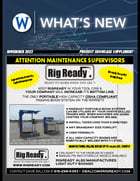 Mark Brewer
Mark Brewer The five ways AI is changing service provision forever in 2024
Machine learning and Artificial Intelligence are increasingly becoming must-have options to assist the growing number of operations and processes in the service industry. Here, Mark Brewer, VP Service Industries at IFS, highlights his five industry predictions—all influenced by AI—for the upcoming year, and the opportunities these new trends open up for the delivery of service, ultimately leading to better customer experiences forever.
- In as little as two years, half of contact centers will rely on an AI copilot
Customer contact centers have always had staffing issues. A global survey by NICE WEM found the contact center attrition rate was an astonishing 42%. Almost a third of agents surveyed were actively looking for a new job, and of those only 60% wanted another contact center role. That’s a lot of disaffected agents.
A move to AI-enabled tech stacks in call centers can change this. It’s poised to increase customer satisfaction and help ease the pressure from rising voice call volumes by keeping agents supported, interested, and engaged.
Gathering the information needed to resolve a customer call about a vehicle breakdown or a broken boiler is not easy. It’s high-stress and complex for the agent. The necessary details and logistical variables may well be held on multiple systems, yet all must be considered together to achieve a call resolution in real time.
Enhancing agent processes with AI applications
AI provides a way to support agents with a virtual assistant—a copilot—in real-time as they work processing calls.
For example, an AI copilot could automatically triage, and visually prioritize, the most urgent calls for agents on a dashboard, based on voice recognition of key phrases mentioned in a request. Similarly, it could display context-sensitive information as the call is in progress—for example, prompts to try and diagnose a fault, or the proximity and travel time of the nearest qualified engineer.
Here, intelligent autonomous technology is not replacing, but instead augmenting the agent, empowering them to deliver a better, more reassuring, and efficient customer experience. Supported by an AI-powered copilot, every agent becomes an expert—including those staff who are new or relatively inexperienced in the role.
- “Circular by Default” will be the new norm for 70% of service organizations by 2026
With increasing global scrutiny on sustainability, consumers and businesses alike want to retain products and equipment for longer.
The circular economy has seen a shift in the sustainability model from stick to carrot: mandatory compliance with regulations has turned into active enthusiasm to become inherently sustainable. Organizations know that consumers now want to buy from environmentally conscious companies.
Equally, the outcome-based service model is also becoming more attractive. As consumers start to subscribe to offers such as heating-as-a-service, suppliers can afford to optimally maintain assets to maximize their lifetime, reducing emissions, waste, and recycling.
I also expect we will start to see self-healing capabilities being designed into new products such as appliances and vehicles, eliminating the cost, time, and environmental impact of unnecessary field service visits.
- Computer Vision will enable 30% of asset-centric organizations to see, observe, and understand the world better by 2027
Where AI enables computers to think, computer vision enables computers to see, observe, and understand. For example, in a manufacturing or process environment, AI can be trained to analyze and detect video imagery that would indicate a fault or safety hazard. Already, computer vision is being used in both the oil and gas and the maritime sectors to monitor and detect corrosion, informing timely manual inspections and preventative maintenance, whilst multi-camera-equipped autonomous robots monitor operations in factories and warehouses.
Increasingly, passenger and commercial vehicles are now equipped with cameras, capturing video as they drive. By applying suitable image recognition algorithms, this stream data can be used for computer vision, and reporting maintenance issues for infrastructure. Examples include road signs obscured by overgrowth, tree growth abrading overhead cables and phone lines, and vehicles automatically detecting and reporting locations for potholes.
- Almost one-third of service organizations will introduce autonomous vehicles to boost productivity initiatives
One of the key metrics in field service has always been productivity (utilization): the amount of a field engineer’s time actually spent on the job. This ‘wrench time’ typically ranges from anything between 50% and 95%, but most organizations are aiming for around 70 to 80% utilization.
Driving can easily occupy 30% of an engineer’s day, with administration adding a further 20-30%. But with the introduction of autonomous vehicles, travel is no longer downtime. With an autonomous vehicle managing the driving, engineers can prepare for their next visit, ensuring they are prepared.
Because autonomous journeys are digitally planned and routed, they are exceptionally efficient and take into account EV range and charging needs. Human drivers need help to perform this well. AI-driven IFS Planning & Scheduling Optimization (PSO) removes all the guesswork. As well as planning the optimum schedule and routes, the application uses real-time vehicle telemetry data to dynamically make changes—for instance stopping to charge for 10 minutes, allowing an engineer to reach two more extra jobs, increasing the engineer’s daily productivity by 50%.
- AI will become the preferred fleet manager for 4 out of 10 asset-centric service providers by 2026
Streamed video data from assets, interpreted by computer vision, will increase the visibility of what the fleet manager can see. For example, wind turbines are routinely equipped with IoT remote sensing. Turbine manufacturers have access to real-time performance and operational data from thousands of assets sold and maintained at hundreds of customer wind farm installations. Thanks to AI, intelligence from cameras, sensors, service records, and digital twin models can give fleet managers ultimate visibility.
AI can quickly identify any wind farm that is performing more efficiently and generating more energy than other comparable sites. Moreover, it can compare specifications to pinpoint why: for example, because a site uses a different, and more effective, gearing calibration. At this point AI has identified a competitive advantage, and a sales opportunity for the manufacturer. It automatically generates a proposal to the operator of the under-performing wind farm site, offering a recalibration service that will deliver a guaranteed outcome of, say, a 20% uplift in power generation efficiency. This entire cycle, including service pricing, has been automatically initiated by AI with little or no human intervention, and no sales calls. Thus, moving from transaction-based sales to a consultative, fact-based, value-added partner.
Enhance efficiency and productivity
Similarly, in a production environment, AI analysis can allow machine manufacturers to enhance efficiency, productivity, and throughput for customers throughout the lifecycle. This takes maintenance beyond preventing downtime to driving operational improvement.
By removing human subjectivity and anticipating changes, AI gives every company the potential to be a leader. Suddenly factors like the weather, sales trends, demand, usage duty, and more are automatically part of an AI-enabled and informed performance picture. Even service no longer needs to be generic: AI can create instance-specific documentation and recommendations, ensuring the right service part and optimal procedure and interval every time.
For example, The Rolls Royce Blue Data Thread program pulls engine performance data from multiple customer aircraft fleets. Using AI analysis, maintenance intervals for similar aircraft models are instance-specific—personalized based on engine use and wear. Alongside other operational suggestions, this value-added service already minimizes unnecessary Aircraft On Ground (AOG) time, increasing operational profitability.
AI continuing to drive new service efficiencies and developments in 2024 and beyond
As AI continues to develop, we will continue to see more and more major disruptions in the service sector that would not have been possible without such technology. The next 12 months and beyond will see AI becoming part of service offerings, assets, and business processes. This is just the beginning of the AI revolution—and the service industry is leading the movement.
About the Author
Vice President for the Service Industry, Mark Brewer, has been helping organizations drive business transformation for over 20 years. From bringing Service Lifecycle Management solutions to market with Servigistics to introducing Connected FSM to the marketplace with PTC. Mark has worked with some of the world’s largest service organizations including Coca-Cola, Dell, GE Healthcare, and ThyssenKrupp. In March 2017, Mark was named as one of the most influential people in field service by Field Service News.









